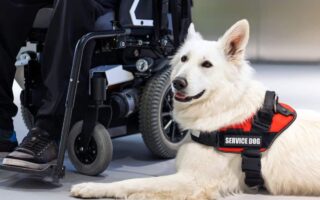Walking your dog should be a joyful experience, but for many pet owners, it can become a tug-of-war fraught with frustration. Teaching your dog to walk on a leash is not just about control; it’s an opportunity to deepen the bond between you and your furry companion. As you embark on this journey together, patience and consistency will be your greatest allies. In this article, we’ll explore effective techniques and invaluable tips that will turn your daily stroll into a seamless adventure, allowing both you and your dog to navigate the world side by side with harmony and confidence. Whether you’re starting with a lively puppy or an older dog set in its ways, mastering the art of leash walking can transform even the simplest outings into a cherished part of your routine. Let’s dive into the essentials of leash training and set the stage for many delightful walks ahead.
Table of Contents
- Understanding Your Dogs Leash Walking Behavior
- Essential Equipment for Successful Leash Training
- Step-by-Step Techniques to Encourage Leash Compliance
- Common Challenges and Solutions in Leash Walking
- Q&A
- In Summary
Understanding Your Dogs Leash Walking Behavior
Understanding your dog’s leash walking behavior is essential for creating a harmonious walking experience. Dogs are naturally curious creatures, often eager to explore their surroundings, and their innate instincts can influence how they react to the leash. When starting leash training, it’s important to pay attention to your dog’s body language. Dogs that pull or tug might be expressing excitement, anxiety, or simply a desire to investigate something interesting. To effectively manage these behaviors, consider the following strategies:
- Consistency: Always use the same commands and techniques during walks to help your dog learn the expected behavior.
- Positive reinforcement: Reward your dog with treats and praise for walking calmly beside you, encouraging them to associate good behavior with positive experiences.
- Start slow: Begin in a low-distraction environment before gradually introducing busier locations to build your dog’s confidence and focus.
Another factor to consider is the type of leash and harness you use. Utilizing the right equipment can significantly impact your dog’s walking behavior. For instance, a front-clip harness can discourage pulling by redirecting your dog’s attention while providing better control. Observing how your dog reacts to different setups can provide insights into their preferences and comfort levels. Here’s a simple comparison of leash types:
| Leash Type | Advantages | Disadvantages |
|---|---|---|
| Traditional Leash | Simple to use, offers solid control | May not discourage pulling |
| Retractable Leash | Allows freedom of movement | Can lead to tangling or pulling |
| Front-Clip Harness | Discourages pulling, better control | Requires adjustment for a proper fit |
Essential Equipment for Successful Leash Training
To embark on a successful leash training journey, having the right gear is crucial. Start with a comfortable collar or harness specifically designed for your dog’s size and breed. A well-fitted harness can prevent strain on their neck, especially for breeds prone to tracheal issues. Additionally, a six-foot leash provides ample space for your dog while maintaining close control, allowing for a safe and enjoyable walking experience. Consider options with padded handles to ensure comfort during long training sessions.
Incorporating training treats into your routine can significantly enhance your leash training. These rewards not only motivate your dog but also reinforce positive behavior when they walk nicely beside you. Moreover, a clicker can be a helpful tool for marking good behavior in real-time, leading to quicker learning. Lastly, don’t underestimate the value of a fanny pack or treat pouch for convenient access to your supplies, keeping your hands free to guide your dog effectively.
Step-by-Step Techniques to Encourage Leash Compliance
To foster a harmonious relationship between you and your dog during walks, start with the basics of leash dynamics. Begin in a quiet area free from distractions, allowing your furry friend to explore the leash. Use positive reinforcement techniques, rewarding your dog with treats and praise every time they walk beside you without pulling. This can condition them to associate the leash with positive experiences. Remember to keep your sessions short and enjoyable, gradually increasing the duration as your dog becomes more comfortable. Incorporating your dog’s favorite toys as distractions can also motivate them to stay focused on you.
Introducing cues during your walks can significantly enhance leash compliance. Use commands such as “heel” or “let’s go” to encourage your dog to stay close, and be consistent with your terminology. Consider setting up a small training table to track your progress. For example:
| Command | Desired Action | Reward Type |
|---|---|---|
| Heel | Stays by your side | Treats |
| Let’s go | Starts walking with you | Praise |
| Stop | Pauses at your side | Affection |
practice makes perfect. Just like humans, dogs thrive on routine and consistency. Schedule regular walks and reinforce good behavior through persistent training sessions. Maintain a calm demeanor, even if your dog occasionally strays from the path. Redirect their attention gently, getting them back on track with motivating cues. Over time, this dedicated routine will transform your walks into enjoyable adventures for both of you.
Common Challenges and Solutions in Leash Walking
Leash walking can often present a series of challenges that can frustrate both dogs and their owners. One common issue is pulling, where the dog gets overly excited and leads the walk instead of following the owner. This can make the experience uncomfortable and even unsafe. Addressing this involves using a few strategies:
- Utilizing a no-pull harness to provide better control
- Incorporating frequent stops during the walk to keep the dog engaged
- Rewarding your dog when they walk beside you to reinforce the desired behavior
Another significant challenge is distractions in the environment, such as other animals, people, or noises. These distractions can lead to your dog becoming overly reactive or excited, complicating the walk further. To mitigate this, owners can:
- Practice leash walking in low-distraction areas before gradually introducing more stimulating environments
- Use treats or toys to redirect the dog’s attention back to the owner
- Teach commands like “leave it” or “watch me” to help regain focus during these moments
Implementing consistent training sessions can resolve these issues over time. Below is a simple table highlighting effective training techniques and their purpose:
| Technique | Purpose |
|---|---|
| Positive Reinforcement | Encourage desired behavior through rewards |
| Gradual Exposure | Familiarize dog with various environments |
| Timing Commands | Reinforce commands when walking to maintain attention |
Q&A
Q&A: Teaching Your Dog to Walk on a Leash
Q: Why is it important to teach my dog to walk on a leash?
A: Walking on a leash is crucial for both your safety and your dog’s. It helps you maintain control in public spaces, prevents your dog from chasing after distractions, and provides essential exercise. Plus, it fosters a stronger bond between you and your furry companion, highlighting that walks are a shared adventure.
Q: What equipment do I need to get started?
A: To embark on this journey, you’ll need a well-fitting collar or harness and a sturdy leash. Opt for a leash that’s about six feet long, as it provides enough freedom for your dog while keeping you in control. Remember, comfort is key—avoid collars that are too tight, and choose a harness if your dog tends to pull.
Q: Any tips on getting my dog accustomed to the leash?
A: Absolutely! Start by letting your dog wear the collar or harness indoors without the leash attached. This creates a positive association. Gradually introduce the leash during playtime, allowing your dog to explore while dragging it around. Once comfortable, encourage them with treats when they walk beside you.
Q: How do I teach my dog to walk without pulling?
A: A popular technique is called “loose leash walking.” Begin by stopping each time your dog pulls ahead. When the leash becomes slack, reward them with a treat or praise. You can also change direction suddenly to keep your dog engaged and prevent pulling. Consistency is vital; practice this regularly.
Q: What should I do if my dog gets distracted during walks?
A: It’s natural for dogs to be curious about their surroundings! If your dog becomes distracted, calmly pause and regain their attention using treats or a favorite toy. Encourage them to focus on you, and continue walking once they’re engaged. Keep training sessions short and fun to maintain their interest.
Q: How long will it take for my dog to learn to walk well on a leash?
A: Patience is key! Each dog learns at their own pace. Some may pick it up in a few weeks, while others might take a couple of months. Regular practice and positive reinforcement will significantly speed up the process, so stay consistent and celebrate small victories along the way.
Q: Can I teach an older dog to walk on leash, or is it easier with puppies?
A: You can certainly teach leash walking to dogs of any age! While puppies may adapt quickly, older dogs can learn just as effectively with the right approach. It may take a bit more patience and time, but remember, the journey can be just as rewarding for an older dog who has perhaps not had structured walks before.
Q: What should I do if my dog refuses to walk at all?
A: If your dog is hesitant or refuses to walk, first assess whether they’re comfortable with the collar and leash. Encourage your dog with treats or toys, and consider taking short steps—literally! Start in your yard or a quiet area before progressing to busier locations. Sometimes, a little bit of encouragement or some treats close to the ground can work wonders.
Q: How can I make leash training enjoyable for my dog?
A: Incorporate fun into the process! Use treats, praise, and frequent play breaks to keep your dog engaged. You can also take different routes or explore new environments as rewards for good behavior. Making walks enjoyable will foster a positive relationship with leash training, making it something they look forward to!
Remember, every dog is unique, and the journey of leash training can vary. With patience, consistency, and a bit of creativity, you and your dog can master the art of walking together!
In Summary
teaching your dog to walk on a leash is not just a practical skill; it’s an opportunity to strengthen the bond between you and your furry companion. With patience, consistency, and a sprinkle of creativity in your training methods, you’ll find that walks can transform from a challenging experience into a joyful adventure. Remember, every dog is different, and it may take time for your pup to learn this new behavior fully. Celebrate the small victories and enjoy the journey as much as the destination. Whether it’s a leisurely stroll through the park or a brisk walk around the neighborhood, a well-trained pup at your side will make every outing even more rewarding. So grab that leash, step outside, and embark on countless memorable walks together!


